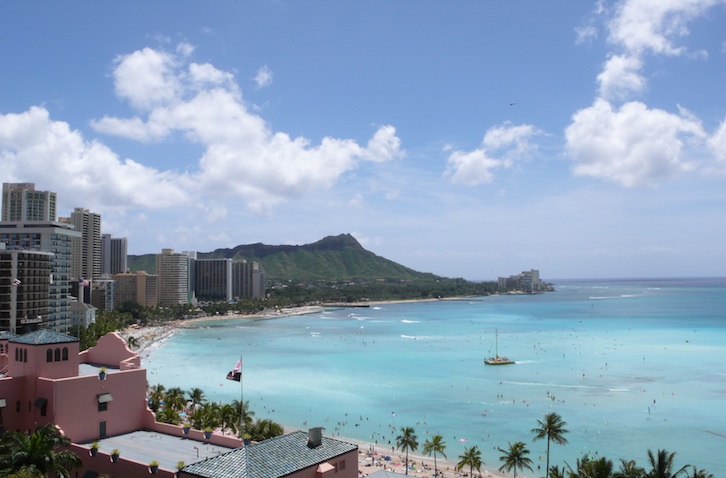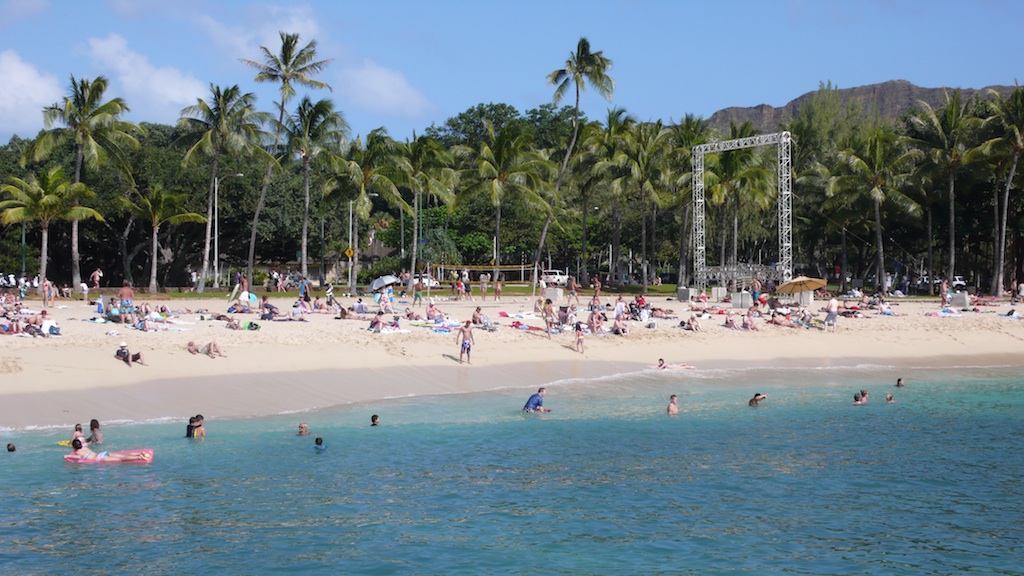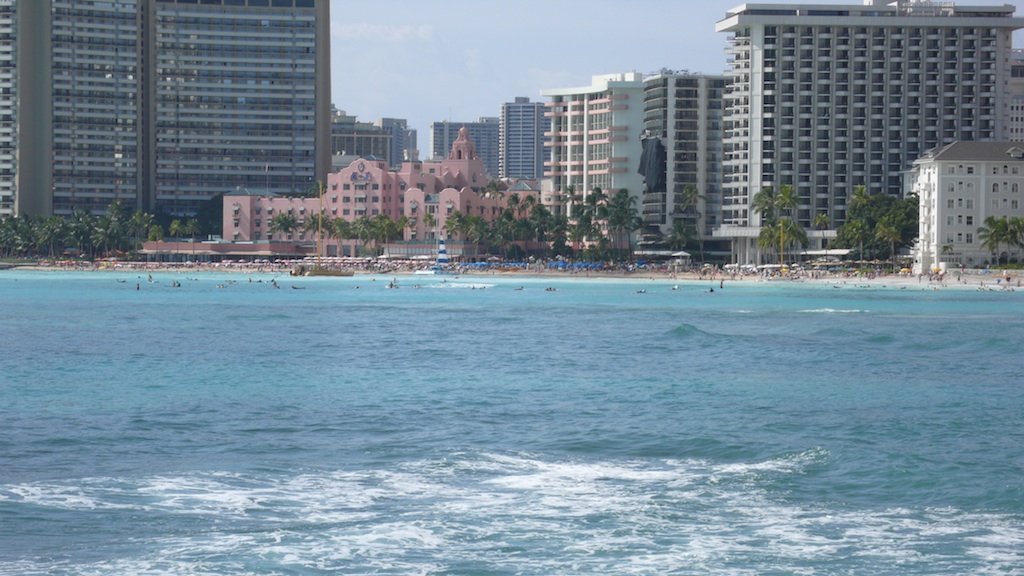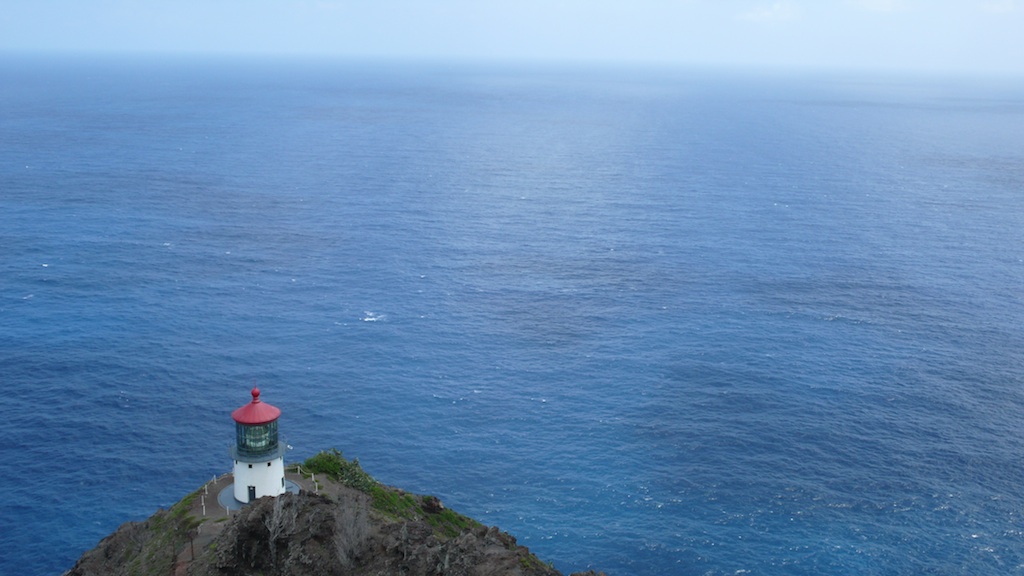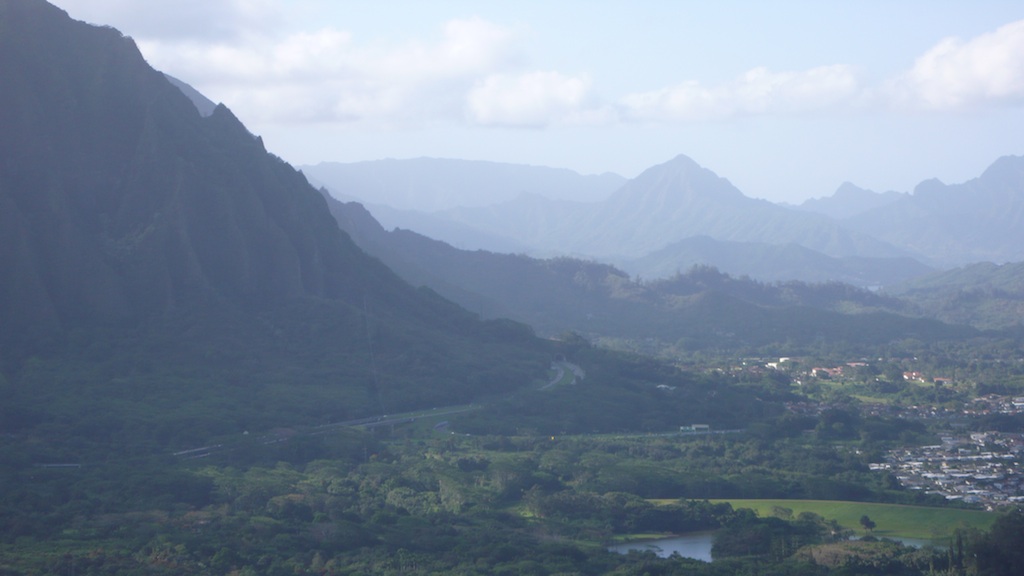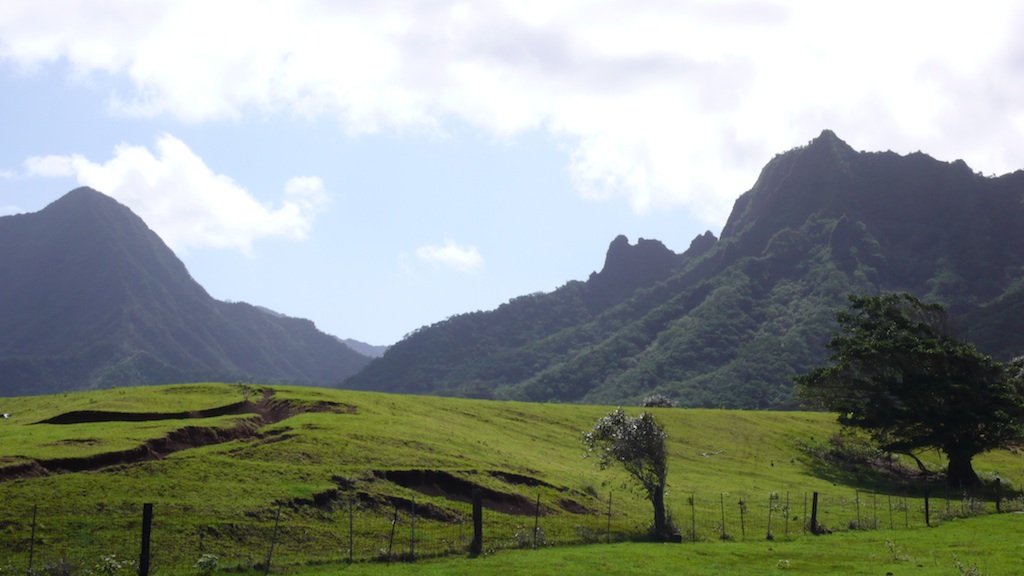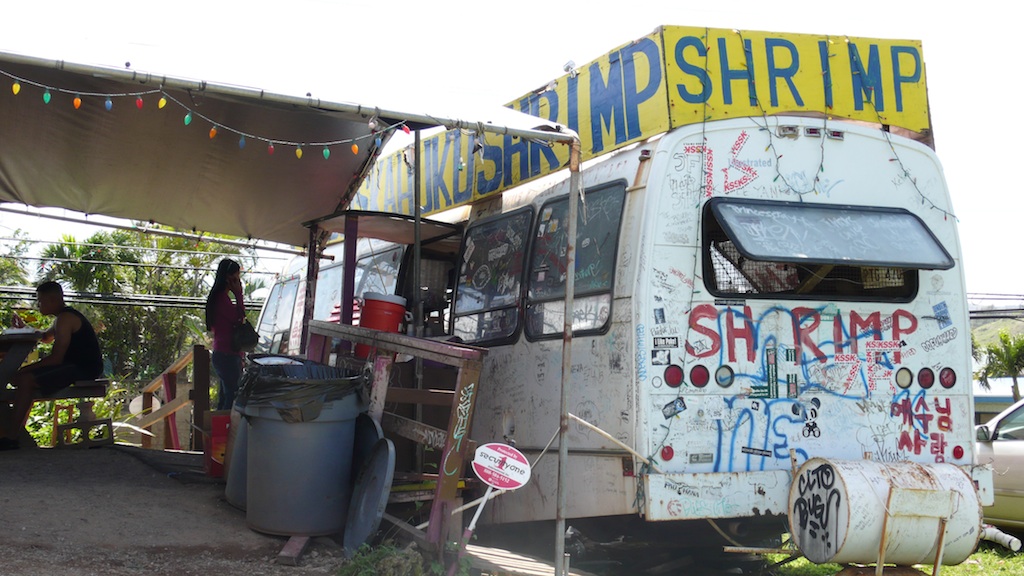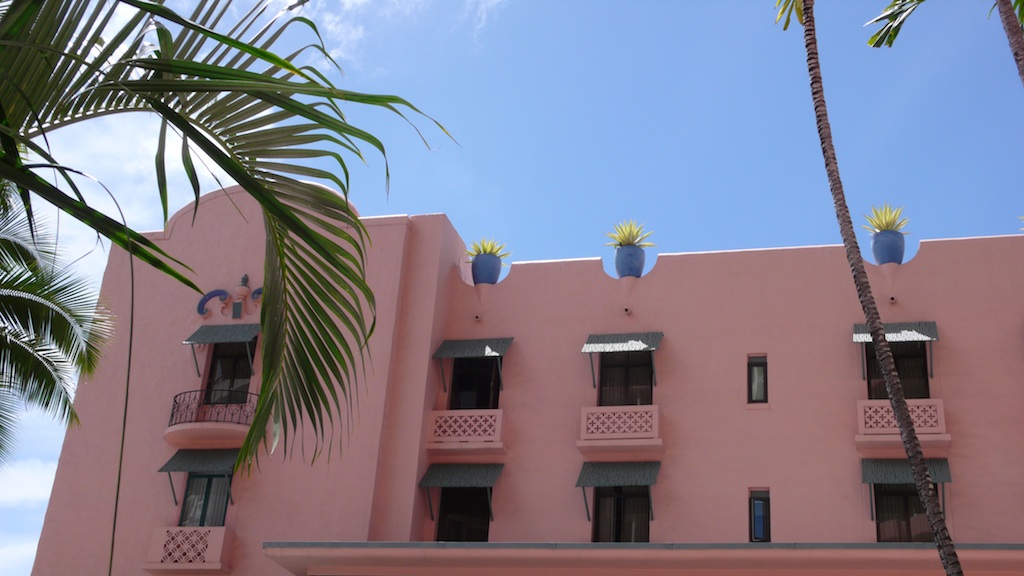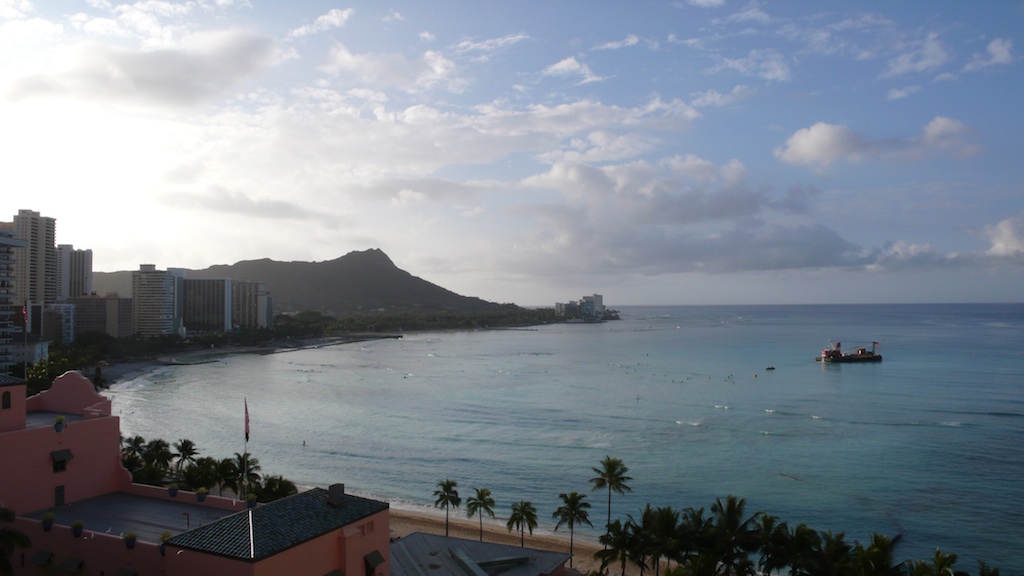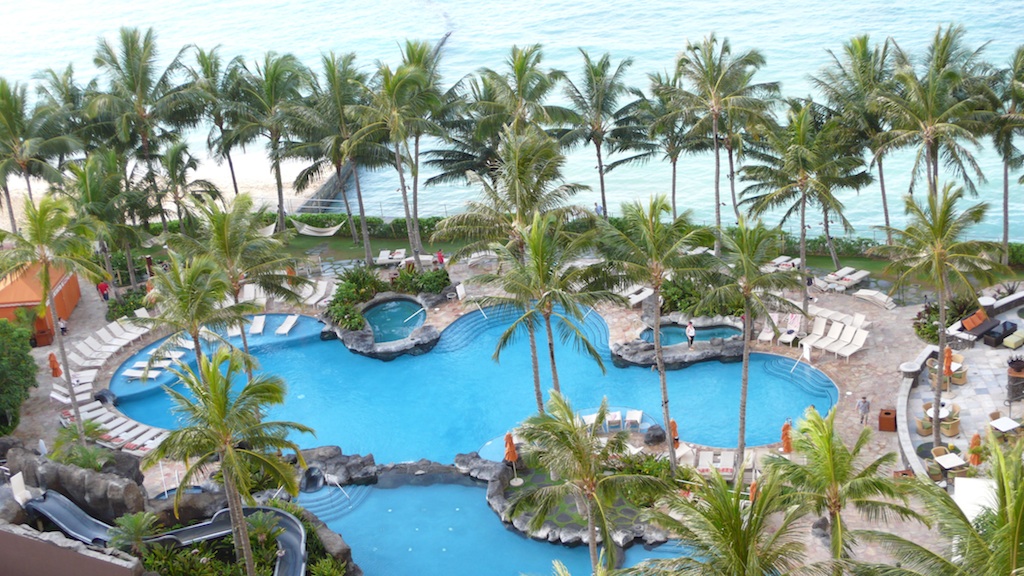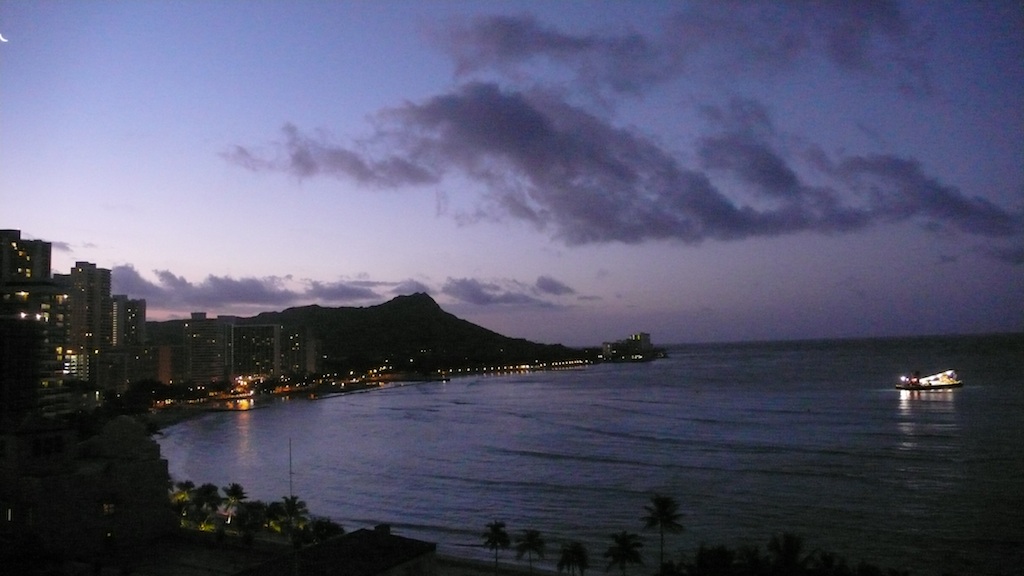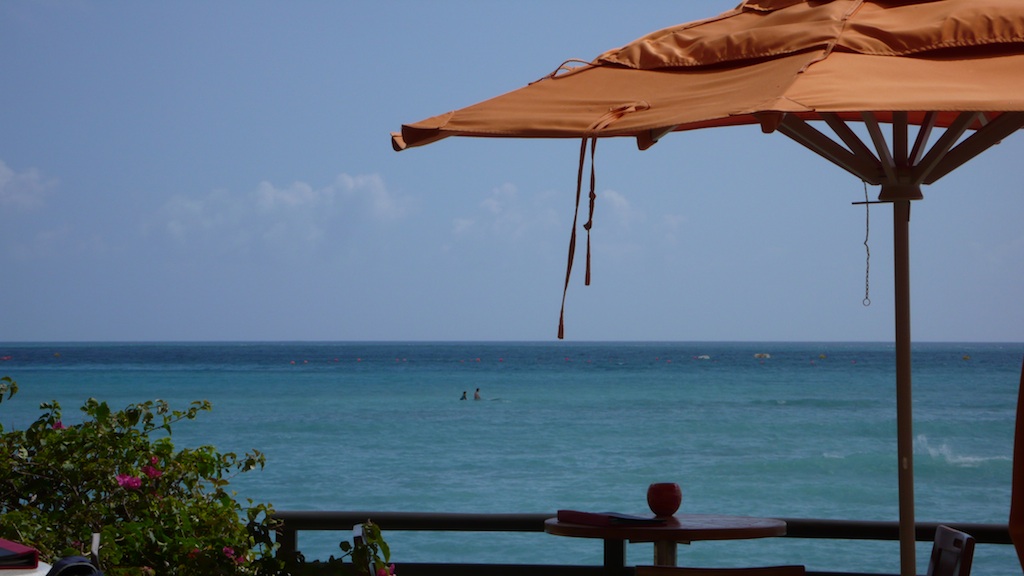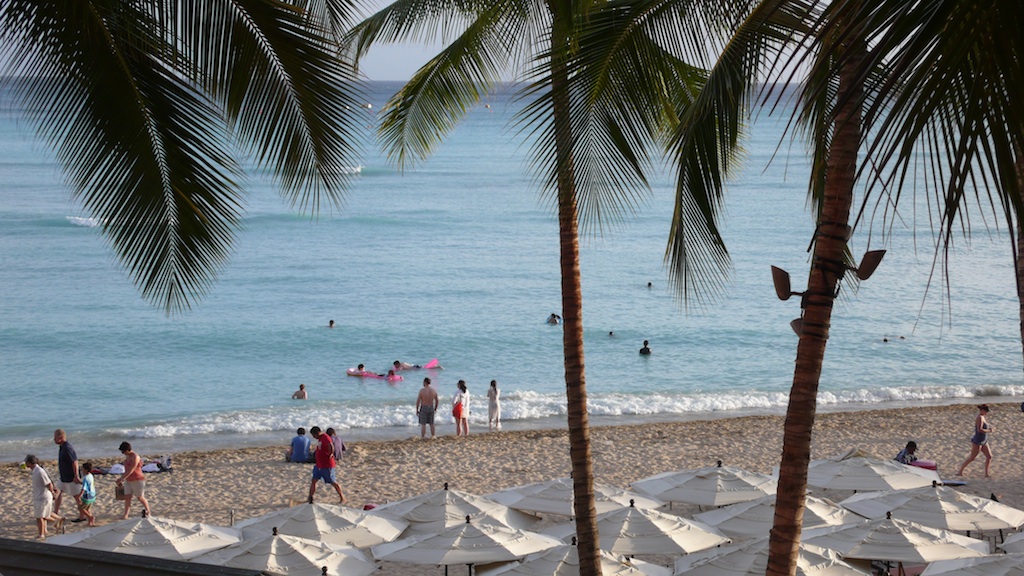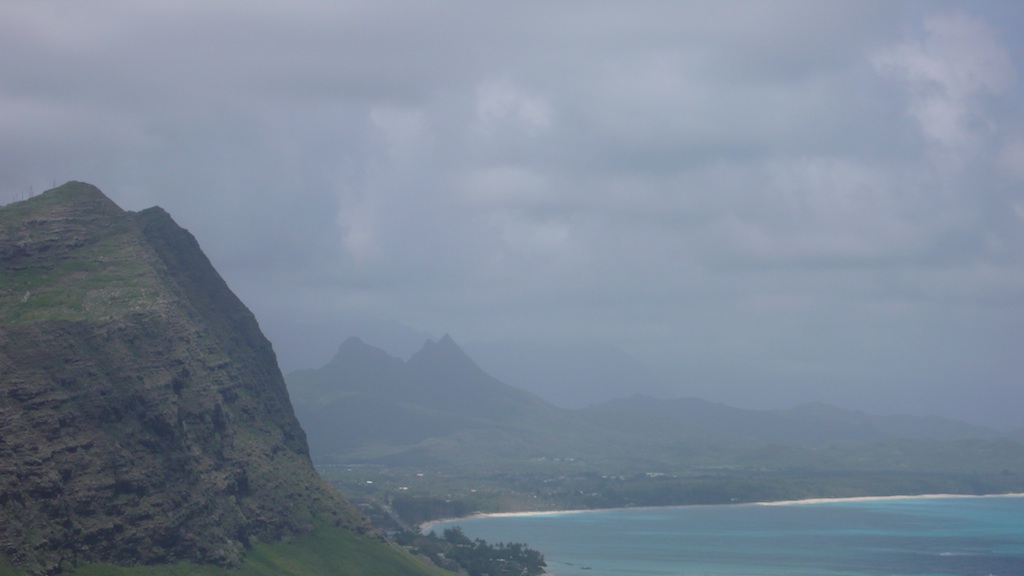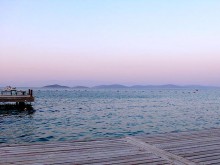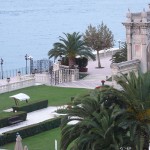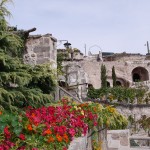The only state not located in North America, Hawaii is a bit like the one family member who escaped a small hometown and became famous. What other state’s name is uttered like a sigh of pleasure? Go ahead, try saying “New Jersey” and see if you get that same lilting lift you get when you say “Hawaii.”
Ever since its admission to the United States in 1959, Hawaii has been synonymous with paradise in the American imagination. With 750 miles of coastline, Hawaii is the only true island state, completely surrounded by water (unlike Rhode “Island,” for example).
If you grew up with television, you probably first saw Hawaii on “Hawaii Five-O” – or “The Brady Bunch.” Or maybe you saw the famous onscreen beach clinch in “From Here to Eternity.” Or else you heard Don Ho, the exemplar of breezy island kitsch, singing “Tiny Bubbles.” Elvis Presley loved Hawaii, the locale for his three Hawaiian movies and his massively popular television special, “Elvis, Aloha from Hawaii.” Bette Midler, who plays the ukulele and sang Hawaiian ditties, was born in Hawaii, as was Nicole Kidman – and of course, Barack Obama, who became the first Hawaiian-born President of the United States.
Across the chain of eight primary islands that make up the state of Hawaii, North American and Asian influences commingle with the islands’ indigenous Polynesian traditions. The result is a sui generis Asian-American culture – and the only state where “Tropical America” is not an oxymoron.
Falling Asleep to the Sound of Ocean Waves
The southernmost state in the US, Hawaii is the only state that grows coffee, the only state with royal palaces, the only state whose second official language is Hawaiian (and whose second “unofficial” language is Japanese) and one of only two states that doesn’t conform to daylight saving time. And, perhaps not surprisingly, Hawaii is also the state whose citizens have the longest lifespan in all the US.
In short, Hawaii is – and is not – American. Hawaii is the closest you can come to living in Japan – while living in the United States.
Since the island republic’s annexation by the States, Hawaii’s dominant industry has been tourism. More than seven million tourists visit annually – and the recent partnership between Hawaiian Airlines and JetBlue will enable East coast visitors direct flights from JFK to Honolulu starting in June 2012. Think about it: you wake to the sound of sirens in Manhattan – and fall asleep to the sound of the ocean waves lapping the shore of Waikiki Beach.
On the south shore of Oahu, east of the airport and downtown Honolulu, rises the neighborhood of Waikiki. For years favored by the Hawaiian monarchy, the fabled stretch of beach became famous worldwide, thanks to Duke Kahanamoku, the five-time Olympic medalist and the global ambassador for the sport of surfing.
All-Night Madison Avenue on the Pacific
Riding in from the airport, particularly when arriving after sunset, Waikiki resembles an all-night Madison Avenue on the Pacific mixed with the more luxurious elements of the Las Vegas Strip. The neighborhood’s primary thoroughfare is Kalakaua Avenue, named for King Kalakaua, whose former grounds now house Luxury Row, a world-class collection of boutiques such as Chanel, Bottega Veneta, Yves Saint Laurent, Tiffany & Co., amongst other usual suspects.
In the evenings, Kalakaua Avenue is a veritable passeggiata of some of the world’s most fashionable consumers of luxury goods. At times like these, surrounded by such ebullient devotees of conspicuous consumption, Waikiki, which means “spouting fresh water” in Hawaiian, might as well mean “willingly open wallet.” Along Kalakaua Avenue, it’s possible to shop stores such as Hermes and Louis Vuitton until nearly midnight, all while surrounded by those similarly obsessed by the spoils of capitalism.
For others of a more metaphysical bent, the allure of Oahu (often referred to as the “heart of Hawaii”) is connected to the fresh, floral air and the warm, tranquil ocean, framed by breathtaking vistas of natural beauty.
Yes, Hawaii is paradise. Nonetheless, as George Clooney intoned in the opening to this year’s Oscar-winning film, “The Descendants,” there are social ills in Hawaii, such as homelessness and obesity – and yet, certainly it’s far better to endure such conditions in paradise, as opposed to, let’s say, Wyoming.
The Capacity for Wonder
Without question, some of the peace of mind that tourists experience in Hawaii is connected to the “aloha spirit” that greets one and all, thanks to a populace that is the very manifestation of serene bliss.
As James Michener, author of “Hawaii” and “Tales of the South Pacific,” wrote, “Without these remarkable people, the island would be nothing. With them, it is a carnival. They are generous, courageous, and comical. They are perpetual adolescents of the ocean, the playboys of the Pacific.”
There’s nothing like a hula lesson at ten in the morning, followed by a surfing lesson on Waikiki Beach, to be reminded of the truth of Michener’s statement – and to realize anew that Ponce de Leon’s cartography was askew. As Michener realized and legions of tourists confirm, the fountain of youth is Hawaii.
For in spite of its slightly kitschy edge and its, arguably, overdeveloped beach, Waikiki retains that quality that Fitzgerald described at the end of “The Great Gatsby” when he wrote that “for a transitory enchanted moment man must have held his breath…face to face for the last time in history with something commensurate to his capacity for wonder.”
As much today as ever, the wonder of Waikiki is commensurate to its capacity for inspiring the joy of life.
WHAT TO DO:
Surfing and Outrigger Canoeing: Waikiki Beach Services @ the Royal Hawaiian: The first global ambassadors for Hawaii were the beach boys of Waikiki: the surfers and the outrigger canoe boys. Armed with surfboards, smiles, and handfuls of leis, Waikiki beach boys of the 1920s (including Olympic swimmer Duke Kahanamoku) greeted visitors with their irrepressible ebullience and indigenous charm as they showed “haole” (mainlanders) how to love the ocean and the beach as much as they did.
More than a century later, that passion and love for Waikiki and the water is perpetuated by the beach boys of Waikiki Beach Services. The infectious energy of this merry group of mer-men enables even the most risk-averse to ride the waves and feel the exhilarating rush of adrenaline and accomplishment.
Never thought you’d surf? Never thought you’d ride a wave? Think again. Sign on with Barney, one of the most equable of a corps of bronzed and buff beach boys, and you’ll be surfing the waves of Waikiki long before your hour-long lesson is complete. Chances are, you’ll feel such a rush that you’ll sign on for an outrigger canoe surfing lesson as well.
Derived from a sport reserved for Hawaii’s royal families, outrigger canoe surfing is one of the safest – and most fun – sports for ocean vessels. Round up your posse and paddle out to the waves for a thrill ride way more righteous than any amusement park.
Waikiki Beach Services also provides stand up paddle lessons (aka SUP) and sunset catamaran sails. They’ll even help you orchestrate a burial at sea (should the need arise…).
As professional as they are fun-loving, the beach boys of Waikiki Beach Services are all state certified to teach – and they work to insure that your time in the cerulean waters below Diamond Head remains one of those memories that linger longer after you’ve left the beach.
Plus you’ll leave with a photo CD to prove to everyone back home that yes, from now on, you’ll answer only to the name of “Duke.”
LINK: Waikiki Beach Services @ the Royal Hawaiian
Moana Lani Spa @ Moana Surfrider: Built in 1901, the Moana Surfrider has earned its sobriquet “the First Lady of Waikiki,” as well as a place on the National Register of Historic Places. For well over a century, massive Ionic columns and a gracious porte cochère have welcomed guests into one of the more fabled hotels in the world.
“Moana” means “wide expanse of ocean” and that is precisely what greets guests at Moana Lani Spa within the Moana Surfrider. Overlooking Waikiki Beach in what was once a second-floor restaurant in the hotel’s Tower Wing, the recently-opened 18,000-square foot spa includes two oceanfront suites, as well as separate men’s and women’s relaxation lounges, all with spectacular, open-air views of the Pacific Ocean.
The traditional “Lomi Lomi Ola” massage is performed by a trained practitioner of Hawaii’s indigenous therapy. Each massage therapist has learned “lomi lomi” from teachers or grandparents whose lineage can be traced to ancient Hawaii. The 80-minute “lomi lomi” (meaning “masseur who rubs with the paws of a contented cat” – or thereabouts, anyway) incorporates various techniques to alleviate tension and pain, with overall well-being as the primary objective.
Each treatment commences with a bowl of Hawaiian sea salt, into which each guest is invited to leave all worries. At day’s end, the collected bowls of salt (and worries) are blessed and carried out to sea.
Treatment rooms at Moana Lani Spa are large and spacious, enabling for greater freedom of thought and deeper breathing. Before and after treatments, clients relax in Vichy shower hydrotherapy rooms, steam rooms, and dry saunas. Whirlpools are located with a direct view onto the ocean and the horizon, thereby providing ringside seating for sunset vistas.
Guests who are so inclined may also utilize the 24-hour fitness center – but seriously, once your therapist is finished with you, you’ll find yourself completely sated by a glass of lemon ice water and that expansive vista of the Pacific. Peace of mind guaranteed.
LINK: Moana Lani Spa @ Moana Surfrider
Kualoa: A 4,000-acre sacred sanctuary of dense rainforests and white sand beaches flanking broad open valleys, the Kualoa Valley was a residence of kings and a training ground for royalty from the 13th to the 18th century before becoming a sugar plantation in the 19th century.
Today, the area (now called Kualoa Ranch) is known to film aficionados as the setting of “Jurassic Park.” Numerous films and television shows have been filmed in the Kualoa Valley, including “Godzilla,” “Mighty Joe Young,” “50 First Dates,” “Pearl Harbor,” and “Lost.” As might be expected, Kualoa Ranch’s most popular tour is the movie site tour. Who can resist a photograph deep inside Godzilla’s footstep?
Adventure tours include horseback riding, jungle expeditions, ocean voyaging, and all-terrain vehicles. Located on the windward side of Oahu (24 miles from Waikiki), Kualoa is also one of Oahu’s largest and oldest cattle ranches and guests who book package tours sit down to a ranch buffet lunch or a prime rib buffet dinner.
In 1974, Kualoa (meaning “long back” for the region’s mountain ridges) was added to the National Register of Historic Places, a testament to the valley’s sacred origins and its breathtaking beauty.
LINK: Kualoa
Haleiwa Town: The surfing capital of Oahu (and arguably the world), the historic town of Haleiwa (pronounced hah-lay-EE-wah and meaning “house of the frigate bird”) dates to the late 19th century when the island was primarily devoted to the sugar industry. Surf and Sea is the largest surf shop in town, while nearby Laniakea Beach is where giant sea turtles sunbathe on the pristine beach.
Stop for a lillikoi (passion fruit) shave (not shaved) ice at local favorite Matsumoto and then head to Haleiwa’s Alii Beach Park where the sunsets are spectacular.
LINK: Haleiwa Town
Matsumoto Shave Ice
Famous Kahuku Shrimp Truck: Simply put, there’s no better way to spend eleven bucks than the garlic butter shrimp plate at Famous Kahuku Shrimp Truck. Served on a bed of lettuce with a side of macaroni salad and white rice, this regional specialty on the island’s north shore is where you’ll find locals eating with their fingers, big smiles on their faces.
While there are numerous shrimp trucks along the Kamehameha Highway, natives swear by Famous Kahuku. The dilapidated, graffiti-strewn truck is part of the charm – and as soon as you sit at one of the famous fuchsia picnic tables and start chowing, you’ll know immediately that you’re in the right place. Lick your fingers – and yes, go ahead, order a second plate: half garlic butter and half coconut shrimp. This is the meal that you’ll be wishing for once you’ve left Paradise.
LINK: Famous Kahuku Shrimp Truck
Dole Plantation: Once you’ve finished your third plate of garlic butter shrimp at Famous Kahuku (see above), head on over to the Dole Plantation. There’s no resisting this tourist favorite; give in to your inner child and order a cone of DoleWhip, the pineapple soft-serve custard that’s served with a slice of pineapple. Be prepared to lick quickly as you wander aimlessly through the pineapple labyrinth, the world’s largest botanical maze.
Awarded a Guinness World Record, the Pineapple Garden Maze encompasses more than three acres of indigenous flora. Those who make it to the labyrinth’s secret heart in record time earn their names at the maze’s entrance.
Rest your weary feet with a ride on the Pineapple Express, a vintage train that winds through two miles of pineapple history to a working pineapple plantation.
And if all this frivolity makes you feel like a kid – enjoy it.
LINK: Dole Plantation
Macadamia Nut Farm: Why not complete your gastronomic afternoon on the windward side of the island with a stop at Tropical Farms, which is more often referred to as the Mac Nut Farm for its plethora of macadamia nuts and mac nut confections? After your garlic shrimp and your DoleWhip cone, make a stop for some of the island’s best 100% whole bean Kona coffee – and a bowl of Cinnamon Glazed Mac Nuts. Or how about a bag of the Kona Coffee Glazed Mac Nuts? And another of the Honey Glazed and one more of the Caramel Coated.
It’s a long flight back to the mainland; use a couple bags of mac nuts to bribe your way into business class. Take it from us; no one can resist these Hawaiian delectables.
LINK: Macadamia Nut Farm
Every Monday evening, the Royal’s Ocean Lawn becomes the setting for a lavish epicurean luau. As the sun sets, the Royal’s guests and assorted locals turn out in white tie and festive attire to sip tropical cocktails while witnessing time-honored indigenous activities such as the pounding of poi.
A five-course dinner features lomi lomi salmon, Portuguese bean soup, lobster tail, and the Royal’s signature Pink Haupia Cake. An open bar insures that spirits remain high throughout the evening’s performances, which include not only hula dancers but also spectacular fire dancers.
By the time the “Aloha Oe” is sung, it’s very hard not to be visibly touched by the history of Hawaii and its lovely people. Sometimes a little kitsch is good for the soul – and when the setting is the Royal, what’s not to love?
LINK: Aha’aina, Royal Hawaiian Luau
WHERE TO STAY:
The Royal Hawaiian: Apart from Diamond Head, the singular most definitive landmark of Waikiki would be “the Pink Palace.” While the Royal Hawaiian is not the oldest luxury hotel on the fabled beach (that honor goes to the Moana Surfrider, which opened in 1901), there’s little question that the Royal has served as the standard-bearer for the deluxe life associated with that storied stretch of beach long associated with royalty.
Built in a Spanish-Moorish style by Warren & Wetmore on a 14-acre parcel of land owned by the Hawaiian monarchy, the Royal Hawaiian opened in 1927 with a lavish black-tie dinner for 1,200 guests – and since then, the Royal Hawaiian has been the paragon of tropical resort life.
A recent multi-million dollar renovation has retained the Royal’s historic character, while insuring that 21st-century guests are as coddled and comfortable as their forebears. An oceanfront junior suite in the historic building is a model of 1920s sophistication, evoking the rooms of decorators Dorothy Draper and Billy Baldwin. With its stunning ocean views, the suite’s spacious lounge evokes classic Hollywood fare such as “Trouble in Paradise” or “The Lady Eve” – and all that is required of you is to shake up a batch of Martinis and host a small catered affair.
The cosseting of guests at the Royal is standard procedure, as exemplified by the remarkably adept staff who frequently appear at the door bearing gifts of freshly-baked breads and muffins, and later, in the evening, a bottle of wine with a welcome note from management.
The hotel’s Coconut Lanai opens onto the Royal’s lushly-landscaped garden – and to wander amidst the abundant tropical flora or to sit under the loggia quietly with a book is to be rewarded with a view onto a nearly-vanished world marked by politesse and courtesy.
For years, the Royal has offered its guests access to the resort’s own private beach (which some people consider the VIP section of Waikiki Beach), complete with chaise lounges and umbrellas.
With its easy elegance and refined sensibility, the Royal is the kind of a hotel where you might see a stylish young mother in the historic lobby followed by a waddling toddler wearing neon pink Crocs – with an Hermes bag upside down on his head. Call Elsa Schiaparelli! Call Salvador Dali!
The point being that throughout the Royal, a sense of decorum commingles beautifully with a sense of fun.
Throughout its history, “the Pink Palace” has offered all sorts of royals a retreat from reality – and on Waikiki, there’s no better refuge for those who enjoy the privileges of a lush sanctuary than the Royal Hawaiian.
LINK: The Royal Hawaiian
Sheraton Waikiki: It’s all about the views. The Sheraton Waikiki is the kind of hotel where you find yourself waking before dawn to marvel at the sunrise from your oceanfront balcony. And that expansive balcony is where you’ll stand at gloaming, cocktail in hand, as the lights of Waikiki shimmer like a diamond necklace all the way to Diamond Head.
When the oceanfront Sheraton Waikiki was built in 1971, the 30-story building with 1,634 rooms and 134 suites was the largest hotel in Hawaii. Thanks to the building’s double crescent shape, more than 80% of the hotel’s rooms feature spectacular cerulean views of the Pacific. And it would be perfectly understandable if you were little inclined to leave your balcony where tropical birds play on the railing while you watch the surfers on Waikiki Beach.
A recent $55 million room renovation at the Sheraton Waikiki has resulted in rooms that have a retro chic atmosphere, a bit like Jonathan Adler romping in the tropics – and in fact, the entire property has a kind of Seventies Brady Bunch exuberance, which is completely infectious. One morning at breakfast, the maitre d’ remarks, “You’re always so happy and energetic in the morning” – to which the only reply is “It’s Hawaii.”
The Sheraton Waikiki’s half-mile beach is flanked by the brand-new Infinity Edge pool, an adults-only oasis where the pool and the ocean appear as a seamless whole body of water. Private cabanas insure privacy and shade, although you’ll find it hard to resist the floating beanbag chairs that enable cocktailing in the water at ocean’s edge.
For those still in touch with the child within, the two-pool Helumoa Playground features a 70-foot long water slide, as well as two whirlpools with incredible panoramic views of the beach, ocean, and horizon.
Kai Market, one of the resort’s five restaurants, offers a daily farm-to-table breakfast buffet featuring homegrown produce for a meal that is inspired by the plantation tables of Hawaii. The multi-ethnic cuisine and local bounty includes such delectables as papaya, Maui strawberries, Kahuku Farms mangos, preserved mustard stem, umezuke, jook, pickled plum, pickled cucumber, braised gluten, sweet melons, coffee jelly, guava bread, and, of course, pineapple.
Eating breakfast al fresco at Kai Market, the Pacific beckoning to you within arm’s reach, is one definition of bliss. This is where you taste the tropical sun in a bite of papaya. And as you as sip your Kona coffee, birdsong in the air, the sea grape and palm trees rustling in the morning breeze, this is where it’s likely that you’ll have a revelation about the beauty of tropical life.
A respite at the Sheraton Waikiki revives your soul.
LINK: Sheraton Waikiki
WHERE TO EAT:
Azure, the Royal Hawaiian: There’s no question that one of the definitions of paradise is to be seated in an oceanfront, world-class restaurant at gloaming, the sun sinking into the horizon as candles flicker at neighboring tables and Pacific Ocean breezes waft through the open doors into a bejeweled dining room adorned with mother-of-pearl walls and plush banquettes. If this isn’t the charmed life, then what is?
Apart from its sublime oceanfront setting, Azure, the Royal Hawaiian’s signature restaurant, offers a classic contemporary interior design that honors the Royal’s storied history of elegance and high standards.
As we gazed toward Diamond Head while sipping from a glass of William Fevre Chardonnay (well chosen by Azure’s personable and charming sommelier, Michael Swerdloff), the setting sun was replaced by the city lights of Waikiki. What other response was there but to toast to happiness?
Executive Chef Jon Matsubara, who earned his stripes at restaurants such as Jean Georges, Tabla, and Bouley in New York, has created a menu befitting a locale beholden to the gifts of the sea. Every morning at 5:30, chefs from Azure frequent the opening of the Honolulu fish auction to handpick the best of the catch.
An ocean salad of Kona lobster, Big Island abalone, scallop, Dungeness crab, octopus, and tobiko caviar was nothing less than a cornucopia of the Pacific’s best gifts. Azure sashimi was a mouth-watering pillow of oceanic flavor: Hawaiian yellowtail ahi and Kona amberjack, accompanied by watermelon radish salad, drizzled in ginger vinaigrette.
Dining by the ocean, eating from the ocean – what could be more elemental?
An intermezzo of lemon basil granita with strawberry pop rocks was the equivalent of a burst of fireworks over Diamond Head. For dessert, a deconstructed Hawaiian Pine”Apple” Crumble, served with crème fraiche gelato, was nothing less than the best of Tropical America – and yes, there is such a thing: it’s called Hawaii.
At meal’s end, a French press of freshly brewed Kona coffee with peaberry was a reminder of how coffee can be as smooth and elegant as a post-prandial liqueur.
In truth, it was tempting to remain seated at the candlelit table alongside the Pacific long after the restaurant had closed. For whenever again would the combination of setting, food, service, and atmosphere conspire in such a perfect form?
Azure is nothing less than flying First Class to heaven.
LINK: Azure @ the Royal Hawaiian
RumFire: With a focus on “social comfort food,” which means the best of global culinary traditions that make you feel happy about what you’re eating (can we say fish tacos and smoked sea salt Yukon fries?), RumFire epitomizes the laidback, chic vibe that percolates throughout the re-energized Sheraton Waikiki.
The oceanfront setting with its unobstructed views to Diamond Head is particularly alluring at gloaming – and made all the more so with a tasting flight of the restaurant’s selection of vintage rums. At lunch, soak up the sun while dining al fresco – and toast to another day in Paradise. RumFire is liquid aloha at its most distilled.
LINK: RumFire Waikiki
WHERE TO PLAY:
Bacchus Bar: The newest addition to Waikiki’s LGBT scene also happens to be one of the best places to meet fun-loving locals while sipping wines by the glass or a signature cocktail. Managed by the same owners of a well-loved Castro bar in San Francisco, Bacchus opened in August 2011 in what was once a wine bar.
Bacchus Waikiki retains the woody, rustic decor for an homage to the god who loosens inhibitions – and on weekends, Bacchus is more fun than a Roman bacchanal. Dionysus would approve.
LINK: Bacchus Bar
Hula’s Bar & Lei Stand: A Waikiki landmark since 1974, Hula’s settled into its current locale some time around the new millennium. After a long run under a massive and beloved banyan tree on Kalaimoku Street (between Kalakaua and Kuhio) where it shared prime real estate with Hamburger Mary’s and its sister bar Dirty Mary’s, Hula’s Bar & Lei Stand moved to the second floor of the Waikiki Grand Hotel, where the open-air bar overlooks Kapiolani Park and Queen’s Beach, another kind of prime real estate.
Apart from the implied lei (get it?) in its full name, Hula’s provides splendid views of Diamond Head, smiling shirtless bartenders, and a crowd that epitomizes the aloha spirit. Go ahead; get happy at Hula’s.
LINK: Hula’s Bar & Lei Stand
LGBT EVENT:
Annual Honolulu Pride Parade: On the 2nd of June 2012, the 22nd annual Honolulu Pride Parade kicks off at ten am from Magic Island. The parade moves down Ala Moana Boulevard to Kalakaua Avenue, winding up in Kapiolani Park for the Pride Celebration, which happens from 11 am to 4 pm. A Pride dance party follows the celebration at McCoy Pavilion.
One thing’s for sure: Honolulu Pride is where everyone gets lei’d.
LINK: Honolulu Pride Parade
WHERE TO SHOP:
Ala Moana Center: Located at the western tip of Waikiki, Ala Moana Center is the largest shopping mall in Hawaii – and the largest open-air mall in the world. Ranked as the second most profitable mall in America, Ala Moana Center is anchored by Neiman Marcus and Nordstrom, with boutiques from the likes of Bulgari, Prada, Louis Vuitton and all the other usual suspects.
What was once the largest mall in the United States is visited by nearly sixty million people annually who shop, eat, preen, and pose at more than 290 stores, restaurants, and bars.
In short, if you’re one of those people (like us) who view shopping as exercise, then Ala Moana Center will be every bit as important to you as a visit to Diamond Head is for a hiker.
LINK: Ala Moana Center
GETTING THERE:
United Airlines: One of the easiest ways to fly to Hawaii from the States is to take the United Airlines direct flight from Newark. And the nine-hour nonstop return flight gives you just enough time to reflect upon why you’re leaving Paradise – and whether or not you should relocate there permanently.
LINK: United Airlines
Hawaiian Airlines: Commencing on the 4th of June 2012, Hawaiian Airlines offers nonstop flights between JFK and Honolulu. Ranked the number one airline serving Hawaii by “Travel + Leisure,” Hawaiian Airlines is the state’s biggest carrier, now celebrating 82 years of continuous service.
The new direct service includes complimentary meals from Hawaii’s Chef Chai Chaowasaree, as well as blankets, videos, and the fabled “aloha spirit” hospitality. With a flight like this, your Hawaiian vacation starts as soon as board the plane.
LINK: Hawaiian Airlines
ADDITIONAL INFO:
Click here for MRNY gallery of Waikiki.
Click here for Go Hawaii, Hawaii’s official tourism site.

